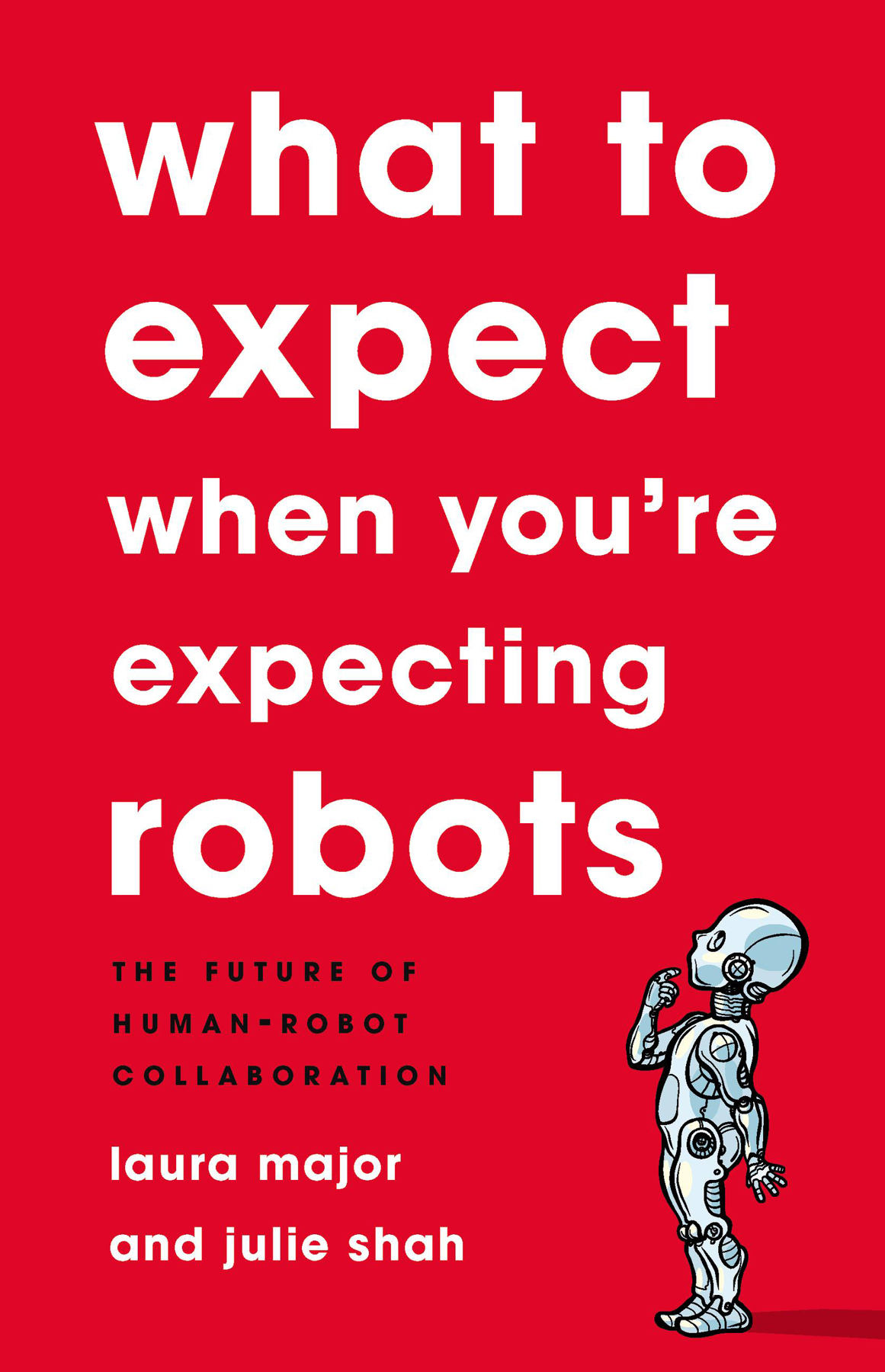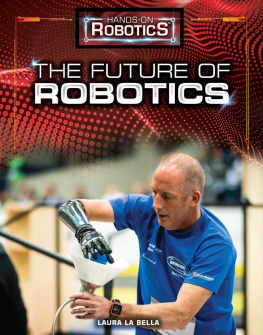Laura Major - What to Expect When Youre Expecting Robots
Here you can read online Laura Major - What to Expect When Youre Expecting Robots full text of the book (entire story) in english for free. Download pdf and epub, get meaning, cover and reviews about this ebook. year: 2020, publisher: Basic Books, genre: Romance novel. Description of the work, (preface) as well as reviews are available. Best literature library LitArk.com created for fans of good reading and offers a wide selection of genres:
Romance novel
Science fiction
Adventure
Detective
Science
History
Home and family
Prose
Art
Politics
Computer
Non-fiction
Religion
Business
Children
Humor
Choose a favorite category and find really read worthwhile books. Enjoy immersion in the world of imagination, feel the emotions of the characters or learn something new for yourself, make an fascinating discovery.

- Book:What to Expect When Youre Expecting Robots
- Author:
- Publisher:Basic Books
- Genre:
- Year:2020
- Rating:5 / 5
- Favourites:Add to favourites
- Your mark:
- 100
- 1
- 2
- 3
- 4
- 5
What to Expect When Youre Expecting Robots: summary, description and annotation
We offer to read an annotation, description, summary or preface (depends on what the author of the book "What to Expect When Youre Expecting Robots" wrote himself). If you haven't found the necessary information about the book — write in the comments, we will try to find it.
What to Expect When Youre Expecting Robots — read online for free the complete book (whole text) full work
Below is the text of the book, divided by pages. System saving the place of the last page read, allows you to conveniently read the book "What to Expect When Youre Expecting Robots" online for free, without having to search again every time where you left off. Put a bookmark, and you can go to the page where you finished reading at any time.
Font size:
Interval:
Bookmark:

Copyright 2020 by Laura Major and Julie Shah
Cover design by Ann Kirchner
Cover image Studiostoks/Shutterstock.com
Cover copyright 2020 Hachette Book Group, Inc.
Hachette Book Group supports the right to free expression and the value of copyright. The purpose of copyright is to encourage writers and artists to produce the creative works that enrich our culture.
The scanning, uploading, and distribution of this book without permission is a theft of the authors intellectual property. If you would like permission to use material from the book (other than for review purposes), please contact permissions@hbgusa.com. Thank you for your support of the authors rights.
Basic Books
Hachette Book Group
1290 Avenue of the Americas, New York, NY 10104
www.basicbooks.com
First Edition: October 2020
Published by Basic Books, an imprint of Perseus Books, LLC, a subsidiary of Hachette Book Group, Inc. The Basic Books name and logo is a trademark of the Hachette Book Group.
The publisher is not responsible for websites (or their content) that are not owned by the publisher.
Library of Congress Cataloging-in-Publication Data
Names: Major, Laura, author. | Shah, Julie, author.
Title: What to expect when youre expecting robots: the future of human-robot collaboration / Laura Major and Julie Shah.
Description: First edition. | New York: Basic Books, 2020. | Series: The future of human-robot collaboration | Includes bibliographical references and index.
Identifiers: LCCN 2020026201 | ISBN 9781541699113 (hardcover) | ISBN 9781541699106 (ebook)
Subjects: LCSH: RoboticsHuman factors. | RobotsForecasting. | Human-machine systemsSocial aspects. | Technological forecasting.
Classification: LCC TJ211.49 .M35 2020 | DDC 629.8/924019dc23
LC record available at https://lccn.loc.gov/2020026201
ISBNs: 978-1-5416-9911-3 (hardcover); 978-1-5416-9910-6 (ebook)
E3-20200909-JV-NF-ORI
Dedicated to our children, Luca, Lily, Lillian, and Vivien,
who inspire us to make a better world.
I MAGINE A WORLD FULL OF ROBOTS. I TS A BIT LIKE THE world of today, except these robots are not just expensive novelties. They arent limited to a small handful of jobs and dont need you to tell them what to do. Instead, these robots are something like partnersthey cooperate with you the same way teammates on the basketball court cooperate with each other. One sets a pick so the other can roll; one lobs the ball high above the basket and another swoops in to dunk. We call this human-robot collaboration, and it is likely to revolutionize our relationship to technology over the next several decades.
People seem to be concerned about whether robots will one day make us obsoletewhether they will become smarter, faster, better than their human creators. But the reality is that robots and humans will probably always be good at different things. And, as we intend to show here, it is possible that some of our most stubborn societal problems could be better addressed by the kind of collaboration we envision. The applications are vast. Through a symbiosis of human and artificial intelligence on the road, we can dramatically reduce fatalities due to car accidents and start to tackle the congestion problems that plague nearly every city in the world. Robots as personal augmentation systems can improve daily well-being and enable us to thrive independently far into old age and as our abilities change. Robotic orderlies can make emergency rooms safer and more efficient, shortening wait times and enhancing care. Robots will bring countless other small but meaningful improvements to our daily lives, and as working moms with an ever-growing to-do list, we personally look forward to these changes.
You may be thinking that robots like this are already here. After all, your Roomba can vacuum your living room on its own. But while your Roombas ability to map your floor plan might seem impressive, it is not really much different from any other household appliance. And this is true of most robots we currently encounter. We restrict their roles with simple rule-based behaviors and interact with them through taps on screens and other simple commands. They understand very little about us, and we request relatively little of them in return. Robots in factories work in cages. We turn on adaptive cruise control for our commute, but turn it off as soon as we hit traffic. We wake up in the morning and ask Siri about the weather, or tell Alexa to add milk to the shopping list, but ultimately, we dress ourselves and buy our own milk. We dont judge our Roomba too harshly when it gets stuck on a tuft of carpet or misses spots. It is a simple machine, not a very smart one. Most robots today have narrow functionality, can only operate in controlled environments, and require essentially constant human oversight. And given those three limitations, they perform beautifully.
But human-robot collaboration is something altogether more revolutionary. New types of intelligent robots are just now beginning to enter our cities and workplaces, and they are defined in large part by the way they transcend these limitations. Robots making package deliveries in our neighborhoods, or shopping for us at grocery storeswhat we call working robotscan no longer be considered mere tools. They amount to new social entities. Let us be clear: whether these robots can be said to be conscious or as intelligent as humans is not really the point, and indeed, many working robots will be a far cry from sentient. What we need to understand about tomorrows robots is that they are going to be something different, with roles mediated at all stages by the rules of social interaction. They will become more human in one specific way: whether they make our lives better or worse comes down to whether they know how to behave.
And there are many of them coming. If the picture we are painting feels like a far-off dream, it is because we are sleeping. There are 1.7 million industrial robots in operation around the world today. And thats not counting the Alexas, Siris, smart home devices, sidewalk delivery robots, grocery store robots, apartment security guard robots, and hospital service robots now making appearances as we visit friends, run errands, and go shopping. Soon, your front yard and our neighborhoods may be swarming with drones. The National Aeronautics and Space Administration (NASA), entrepreneurs, and industry leaders are working quickly to open up our skies to urban air mobilitywhere drones deliver small packages and passengers zip across town in the air over roadway traffic.
I T IS T UESDAY MORNING. Y OU STEP OUT OF YOUR HOUSE AND WALK toward your car, which is parked on the street. Meanwhile, a delivery robot is zipping down the sidewalk, attempting to deliver packages in time for the single-day shipping deadline. It detects you as a nearby obstacle and stops for safety, but not in time. You snag your foot on it and lurch forward, catching your fall. Its already a bad way to start a day. As you drive to work, you pause for a pedestrian to cross the street, and just as you proceed you spot a small assistant robot, probably carrying the persons laptop and lunch, trailing behind. Its low to the ground, like a puppyand you almost didnt see it. You slam on the brakes, narrowly avoiding the robot with its cargo of laptop and sandwich, but the car behind you gently rear-ends you. After you thankfully confirm there was little damage to either of your bumpers, you get back on the road, but you feel the frustration grow when you realize you are now behind an autonomous vehicle doing a test run through a new neighborhood. It feels like time has slowed while you pace behind the vehicle at just below the speed limit, stopping for every object within ten feet regardless of whether the object is actually on the road. Youre ready to pull your hair out by the time you arrive at the office, only to be stuck at the elevator bank by a delivery robot that you cant get to move out of the way of the buttons. It is only 9:00 a.m., and four different robots have already made your life more difficult, simply because they have not been designed to understand or care about you. You cant help but wonder who these robots are really helping.
Font size:
Interval:
Bookmark:
Similar books «What to Expect When Youre Expecting Robots»
Look at similar books to What to Expect When Youre Expecting Robots. We have selected literature similar in name and meaning in the hope of providing readers with more options to find new, interesting, not yet read works.
Discussion, reviews of the book What to Expect When Youre Expecting Robots and just readers' own opinions. Leave your comments, write what you think about the work, its meaning or the main characters. Specify what exactly you liked and what you didn't like, and why you think so.







